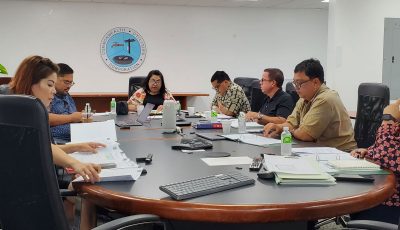CUC in 1st phase of solar power project
The Commonwealth Utilities Corp. is in the first phase of its planned implementation of a utility scale photovoltaic solar farm with a battery energy storage system on Saipan, with a capacity to produce 20 megawatts.
When completed, the project will be the CNMI’s first photovoltaic solar farm with battery energy storage system and the third largest solar farm in Micronesia behind Guam’s two utility scale solar farms.
The Renewables Program project would be a public private partnership between CUC, the CNMI government, and potential independent Renewables Group wherein the CNMI government will provide public lands available to CUC for engineering evaluation on utility scale solar interconnection.
CUC’s project team of engineers are managing the project through the preliminary design, permitting and up to the project construction working with International Engineering Groups, CNMI Teams, National Renewable Energy Laboratory, and the Guam Power Authority.
The engineering design and feasibility evaluation work is performed by the international renewables engineering company S&C Group. S&C was awarded a competitive bid for architectural and engineering services by CUC’s internal source selection committee.
Project funding was obtained from the CNMI Office of Grants Management through the Energizing Insular Communities Grant Program under the U.S. Department of Insular Affairs.
CUC’s interest to integrate utility scale photovoltaic solar with battery energy storage system into the Saipan power grid stems from the potential financial savings that can be realized from long-term reduced cost of service and a potential rate component that can be considered with the current CUC rate structure.
The world-class 20-megawatt photovoltaic power project is scheduled to be commercially commissioned for CUC entering the second quarter of 2025.
According to CUC, the cost of service from CUC’s diesel- power generations facilities is much more expensive than a photovoltaic solar farm of the same size. With CUC expected to replace more than 60% of current generation production from diesel power generators with PV solar power, CUC will reduce the ongoing operation and maintenance expenses from its diesel units. Further potential savings will be realized as CUC’s fuel can be mitigated from price hedging on any rise in the price of fuel in the Singapore market. O&M and fuel savings can be reinvested in capital improvement projects and into the future of CUC power and energy systems.
The “state-of-the-art” photovoltaic solar and BESS system will provide the CUC electric power systems in providing additional available energy and capacity for the power system, it will help stabilize the electrical grid systems through power usage spikes, peak power consumption periods, and provide for quicker response to disaster recovery throughout the CUC power electrical systems.
“The CNMI will be benefiting from the contemporary technological advancements in higher-rated efficient and less expensive BESS systems, lower costs project components (solar panels, inverters, racking, control systems) that were not previously available. These contemporary technological advancements will improve the overall efficiency and the quality of these solar generation equipment,” said CUC executive director Gary Camacho. (PR)



























